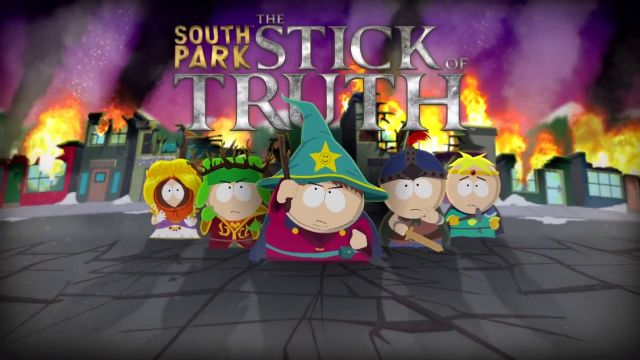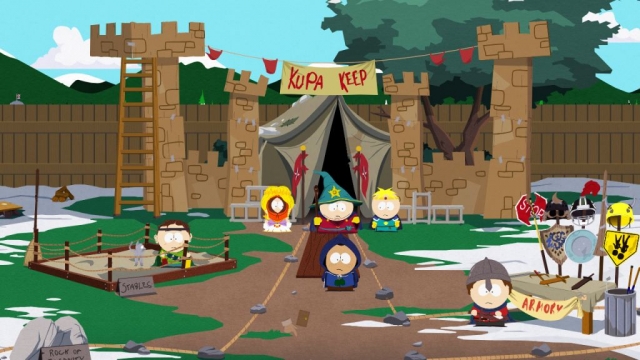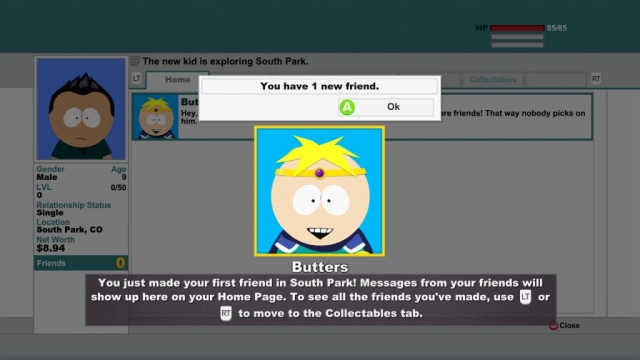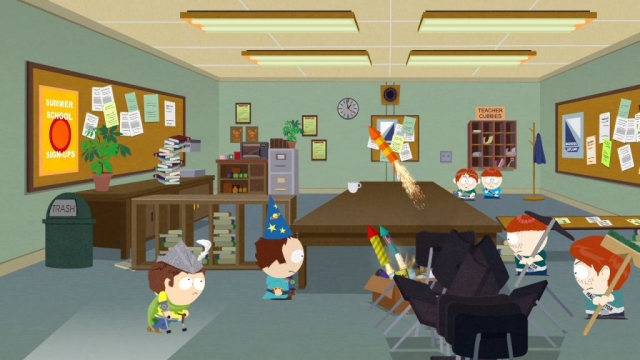South Park: The Stick of Truth

It’s finally here. After a rocky development period that was peppered with a myriad of obstacles, including a few delays, and the closure of its original publisher, THQ, South Park: The Stick of Truth is out. Seriously. You can buy it right now if you want, though I’d suggest you finish reading this review first.
I won’t bury the lead; this is quite possibly one of the funniest games I’ve ever played. It should run you roughly 10-12 hours to complete — admittedly, a little on the short side for an RPG — but it’s consistently funny. There’s nary a lull in the humor, though a majority of it will likely only appeal to fans of the television series.
Speaking of which, if you’re an avid watcher of the show, you’re going to love this. It’s a love letter wrapped up in a plethora of references, some of which will only be caught by hardcore fans.
It’s helped in no small part by the fact that it looks almost identical to the show. There’s a bit of stuttering here and there (an issue that seems to plague the console versions more than PC), but the characters, world, and animations are all straight out of the show.
For the entirety of its running time, The Stick of Truth pulls from each of the show’s 17 seasons, resulting in a deep well of humor and references that reveal themselves at a pretty consistent rate. If the idea of mainlining a couple seasons of the TV series sounds like a fun time, this game isn’t likely to disappoint. It’s just as addictive as the show, possibly even moreso now that it’s been made interactive.
Also, this is the first game to have South Park co-creators Matt Stone and Trey Parker on in an in-depth role. They had a hand in everything, and the final result reflects that. I can’t imagine playing a South Park game without their involvement. Hopefully we won’t have to.
The game starts off strong enough, as you step into the 2D cutout shoes of the new kid on the block, whom you can name, though there’s little point in that seeing as everyone will refer to you as either the new kid or they’ll use the Douchebag monicker Cartman immediately bestows upon you.
There are four classes: Fighter, Mage, Thief, and Jew. Yes, Jew. I chose Mage, the spell-centric class, but if you’d prefer to get up close and personal the Fighter and Thief are each solid choices for those who enjoy strength or speed, respectively, and the Jew class, which I’d reserve for more advanced players as it’s primary skill is increased damage when low on health.
My biggest complaint about this game is the gameplay, which can grow a little stale after awhile. In stark contrast to the rest of the game, it’s not terribly deep. There’s little variety in the turn-based combat outside of choosing to unleash an ability or use melee or ranged combat. Having to time your attacks, guards, and counter-attacks adds a small layer of depth to it, but it’s not enough to keep it from becoming repetitive.
The rest of the game is surprisingly deep. Throughout your journey you’ll come across many of South Park’s residents — some familiar, some not — who can be befriended, usually after you’ve done something for them. This is where the side quests come in. Most characters will have you embark on a short quest to earn their favor, as well as their coveted Facebook friend request. The more friends you collect, the more perks you unlock, so there’s significant motivation in place to urge players to complete as much of the game as possible.
A neat feature that’s tied into this is the activity feed, which works similarly to a wall on Facebook. In it, your character’s friends interact with each other and offer helpful hints related to current objectives.
There are plenty of genre mainstays to be picked over by fans of the turn-based RPG genre, like debuffs, which include familiar effects like “bleeding” and “burning” — the “grossed out” and “pissed off” debuffs are nice touches, too. The map is nice and big, though it can occasionally prove frustrating to navigate.
The leveling system is very much present, and it’s tied into the character customization. On top of choosing your character’s distinct look, class, and fighting style, you can also choose your gear, perks, abilities, and weapons. The armor and weapons can even be improved using patches and “strap ons” — this is a South Park game, after all — that provide small bonuses.
If you’re as ridiculously into character customization as I am, you’ll be happy to hear that Obsidian went above and beyond in this department. The aforementioned gear affects your character’s look when equipped, it can also be dyed, and some of the loot you’ll find on your journey will include special hair, eyewear, makeup, and accessories (the latter includes chinballs, which I giddily applied to my character immediately after find them).
As a game, South Park: The Stick of Truth is enjoyable, if imperfect. It’s successful both as a moderately deep turn-based RPG and as a parody of pop culture, including video games, which it pokes plenty of fun at, rarely with subtlety.
This is most definitely a must-buy if you’re a fan of the brand, but even if you aren’t, The Stick of Truth is an incredibly well-made game with a fantastic sense of humor, a unique art style — at least in relation to other games — and deep character customization.
Reviewed By: Adam Dodd
Publisher: Ubisoft
Rating: 90%
——————————————————————————–
This review is based on a retail copy of South Park: The Stick of Truth for the PlayStation 3 provided by Ubisoft.
 Game Over Online
Game Over Online











